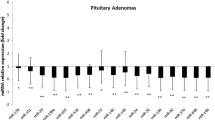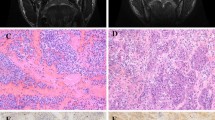Abstract
Purpose
Pituitary carcinomas are extremely rare neoplasms, and molecular events leading to malignant pituitary transformation are largely unknown. Enhanced understanding of molecular mechanisms driving malignant pituitary progression would be beneficial for pituitary carcinoma diagnosis and treatment.
Methods
Differential microRNA expression in paired primary and metastatic pituitary carcinoma specimens were detected using high-throughput human microRNA microarrays and TaqMan microRNA arrays. Three of significantly deregulated miRNAs were further confirmed using quantitative real-time PCR in the metastatic carcinoma, six atypical pituitary adenomas and eight typical pituitary adenomas. Target genes of microRNAs were bioinformatically predicated and verified in vitro by Western blotting and real-time PCR and in vivo by immunohistochemistry respectively.
Results
We present a case of a 50-year-old woman harboring non-functioning pituitary carcinoma with multiple intracranial metastases, and identified up-regulation of miR-20a, miR-106b and miR-17-5p in the metastatic carcinoma as compared to the primary neoplasm. Furthermore, miR-20a and miR-17-5p were increased in the metastatic carcinoma and six atypical pituitary adenomas as compared to eight typical pituitary adenomas as measured by quantitative real-time PCR. Both PTEN and TIMP2 were bioinformatically predicated and confirmed in vitro as target genes of these three microRNAs. As semi-quantified by immunohistochemistry, PTEN was absent and TIMP2 was decreased in the metastatic pituitary carcinoma as compared to pituitary adenomas.
Conclusions
Our results suggest microRNA involvement in malignant pituitary progression, whereby increased miR-20a, miR-106b and miR-17-5p promote metastasis by attenuating PTEN and TIMP2 in pituitary carcinoma.





Similar content being viewed by others
References
Lloyd RV, Kovacs K, Young WF Jr, Farrel WE, Asa SL, Trouillas J et al (2004) Pituitary tumors: introduction. In: DeLellis RA, Lloyd RV, Heitz PU, Eng C (eds) Tumors of pituitary, chapter 1. Pathology and genetics of tumours of endocrine organs. World Health Organization Classification of Tumours. IARC Press, Lyon
Amar AP, Hinton DR, Krieger MD, Weiss MH (1999) Invasive pituitary adenomas: significance of proliferation parameters. Pituitary 2:117–122
Thapar K, Kovacs K, Scheithauer BW, Stefaneanu L, Horvath E, Pernicone PJ et al (1996) Proliferative activity and invasiveness among pituitary adenomas and carcinomas: an analysis using the MIB-1 antibody. Neurosurgery 38(99–106):106–107
Kaltsas GA, Grossman AB (1998) Malignant pituitary tumours. Pituitary 1:69–81
Ragel BT, Couldwell WT (2004) Pituitary carcinoma: a review of the literature. Neurosurg Focus 16:E7
Sironi M, Cenacchi G, Cozzi L, Tonnarelli G, Iacobellis M, Trere D et al (2002) Progression on metastatic neuroendocrine carcinoma from a recurrent prolactinoma: a case report. J Clin Pathol 55:148–151
Bartel DP (2004) MicroRNAs: genomics, biogenesis, mechanism, and function. Cell 116:281–297
Cuellar TL, McManus MT (2005) MicroRNAs and endocrine biology. J Endocrinol 187:327–332
Calin GA, Croce CM (2006) MicroRNA signatures in human cancers. Nat Rev Cancer 6:857–866
Ma L, Weinberg RA (2008) MicroRNAs in malignant progression. Cell Cycle 7:570–572
Butz H, Liko I, Czirjak S, Igaz P, Korbonits M, Racz K et al (2011) MicroRNA profile indicates downregulation of the TGFbeta pathway in sporadic non-functioning pituitary adenomas. Pituitary 14:112–124
Cheunsuchon P, Zhou Y, Zhang X, Lee H, Chen W, Nakayama Y et al (2011) Silencing of the imprinted DLK1-MEG3 locus in human clinically nonfunctioning pituitary adenomas. Am J Pathol 179:2120–2130
D’Angelo D, Palmieri D, Mussnich P, Roche M, Wierinckx A, Raverot G et al (2012) Altered microRNA expression profile in human pituitary GH adenomas: down-regulation of miRNA targeting HMGA1, HMGA2, and E2F1. J Clin Endocrinol Metab 97:E1128–E1138
Leone V, Langella C, D’Angelo D, Mussnich P, Wierinckx A, Terracciano L et al (2014) Mir-23b and miR-130b expression is downregulated in pituitary adenomas. Mol Cell Endocrinol 390:1–7
Palmieri D, D’Angelo D, Valentino T, De Martino I, Ferraro A, Wierinckx A et al (2012) Downregulation of HMGA-targeting microRNAs has a critical role in human pituitary tumorigenesis. Oncogene 31:3857–3865
Palumbo T, Faucz FR, Azevedo M, Xekouki P, Iliopoulos D, Stratakis CA (2013) Functional screen analysis reveals miR-26b and miR-128 as central regulators of pituitary somatomammotrophic tumor growth through activation of the PTEN-AKT pathway. Oncogene 32:1651–1659
Stilling G, Sun Z, Zhang S, Jin L, Righi A, Kovacs G, Korbonits M, Scheithauer BW, Kovacs K, Lloyd RV (2010) MicroRNA expression in ACTH-producing pituitary tumors: up-regulation of microRNA-122 and -493 in pituitary carcinomas. Endocrine 38:67–75
Trivellin G, Butz H, Delhove J, Igreja S, Chahal HS, Zivkovic V, McKay T, Patocs A, Grossman AB, Korbonits M (2012) MicroRNA miR-107 is overexpressed in pituitary adenomas and inhibits the expression of aryl hydrocarbon receptor-interacting protein in vitro. Am J Physiol Endocrinol Metab 303:E708–E719
Melmed S (2011) Pathogenesis of pituitary tumors. Nat Rev Endocrinol 7:257–266
Chen C, Ridzon DA, Broomer AJ, Zhou Z, Lee DH, Nguyen JT et al (2005) Real-time quantification of microRNAs by stem-loop RT-PCR. Nucleic Acids Res 33:e179
Livak KJ, Schmittgen TD (2001) Analysis of relative gene expression data using real-time quantitative PCR and the 2(-Delta Delta C(T)) Method. Methods 25:402–408
Feng ZZ, Chen JW, Yang ZR, Lu GZ, Cai ZG (2012) Expression of PTTG1 and PTEN in endometrial carcinoma: correlation with tumorigenesis and progression. Med Oncol 29:304–310
Rhodes A, Jasani B, Balaton AJ, Miller KD (2000) Immunohistochemical demonstration of oestrogen and progesterone receptors: correlation of standards achieved on in house tumours with that achieved on external quality assessment material in over 150 laboratories from 26 countries. J Clin Pathol 53:292–301
Lee YS, Dutta A (2009) MicroRNAs in cancer. Annu Rev Pathol 4:199–227
Gadelha MR, Kasuki L, Denes J, Trivellin G, Korbonits M (2013) MicroRNAs: suggested role in pituitary adenoma pathogenesis. J Endocrinol Invest 36:889–895
Fan X, Liu Y, Jiang J, Ma Z, Wu H, Liu T et al (2010) miR-20a promotes proliferation and invasion by targeting APP in human ovarian cancer cells. Acta Biochim Biophys Sin 42:318–324
Huang G, Nishimoto K, Zhou Z, Hughes D, Kleinerman ES (2012) miR-20a encoded by the miR-17-92 cluster increases the metastatic potential of osteosarcoma cells by regulating Fas expression. Cancer Res 72:908–916
Chang Y, Liu C, Yang J, Liu G, Feng F, Tang J et al (2013) MiR-20a triggers metastasis of gallbladder carcinoma. J Hepatol 59:518–527
Poliseno L, Salmena L, Riccardi L, Fornari A, Song MS, Hobbs RM et al (2010) Identification of the miR-106b ~ 25 microRNA cluster as a proto-oncogenic PTEN-targeting intron that cooperates with its host gene MCM7 in transformation. Sci Signal 3:a29
Yau WL, Lam CS, Ng L, Chow AK, Chan ST, Chan JY et al (2013) Over-expression of miR-106b promotes cell migration and metastasis in hepatocellular carcinoma by activating epithelial-mesenchymal transition process. PLoS one 8:e57882
Fang L, Li H, Wang L, Hu J, Jin T, Wang J et al (2014) MicroRNA-17-5p promotes chemotherapeutic drug resistance and tumour metastasis of colorectal cancer by repressing PTEN expression. Oncotarget 5:2974–2987
Carthew RW, Sontheimer EJ (2009) Origins and mechanisms of miRNAs and siRNAs. Cell 136:642–655
Lewis BP, Burge CB, Bartel DP (2005) Conserved seed pairing, often flanked by adenosines, indicates that thousands of human genes are microRNA targets. Cell 120:15–20
Cantley LC, Neel BG (1999) New insights into tumor suppression: pTEN suppresses tumor formation by restraining the phosphoinositide 3-kinase/AKT pathway. Proc Natl Acad Sci USA 96:4240–4245
Mayo LD, Donner DB (2002) The PTEN, Mdm2, p53 tumor suppressor-oncoprotein network. Trends Biochem Sci 27:462–467
Yamada KM, Araki M (2001) Tumor suppressor PTEN: modulator of cell signaling, growth, migration and apoptosis. J Cell Sci 114:2375–2382
Zhang LL, Liu J, Lei S, Zhang J, Zhou W, Yu HG (2014) PTEN inhibits the invasion and metastasis of gastric cancer via downregulation of FAK expression. Cell Signal 26:1011–1020
Ma F, Zhang J, Zhong L, Wang L, Liu Y, Wang Y et al (2014) Upregulated microRNA-301a in breast cancer promotes tumor metastasis by targeting PTEN and activating Wnt/beta-catenin signaling. Gene 535:191–197
Wong GS, Rustgi AK (2013) Matricellular proteins: priming the tumour microenvironment for cancer development and metastasis. Br J Cancer 108:755–761
Danilewicz M, Sikorska B, Wagrowska-Danilewicz M (2003) Prognostic significance of the immunoexpression of matrix metalloproteinase MMP2 and its inhibitor TIMP2 in laryngeal cancer. Med Sci Monit 9:T42–T47
Kazes I, Elalamy I, Sraer JD, Hatmi M, Nguyen G (2000) Platelet release of trimolecular complex components MT1-MMP/TIMP2/MMP2: involvement in MMP2 activation and platelet aggregation. Blood 96:3064–3069
DeClerck YA, Perez N, Shimada H, Boone TC, Langley KE, Taylor SM (1992) Inhibition of invasion and metastasis in cells transfected with an inhibitor of metalloproteinases. Cancer Res 52:701–708
Li H, Lindenmeyer F, Grenet C, Opolon P, Menashi S, Soria C et al (2001) AdTIMP-2 inhibits tumor growth, angiogenesis, and metastasis, and prolongs survival in mice. Hum Gene Ther 12:515–526
Nuovo GJ, MacConnell PB, Simsir A, Valea F, French DL (1995) Correlation of the in situ detection of polymerase chain reaction-amplified metalloproteinase complementary DNAs and their inhibitors with prognosis in cervical carcinoma. Cancer Res 55:267–275
Scheithauer BW, Kovacs KT, Laws EJ, Randall RV (1986) Pathology of invasive pituitary tumors with special reference to functional classification. J Neurosurg 65:733–744
Scheithauer BW, Kurtkaya-Yapicier O, Kovacs KT, Young WJ, Lloyd RV (2005) Pituitary carcinoma: a clinicopathological review. Neurosurgery 56:1066–1074
Kontogeorgos G (2005) Classification and pathology of pituitary tumors. Endocrine 28:27–35
Pasquel FJ, Vincentelli C, Brat DJ, Oyesiku NM, Ioachimescu AG (2013) Pituitary carcinoma in situ. Endocr Pract 19:e69–e73
Acknowledgments
We thank Dr. Shijuan Gao (Institute of Microbiology, Chinese Academy of Sciences, Beijing, China) for her advice on this work. This work was supported by the National Natural Science Foundation of China (No. 81072084 and No. 81372414) and Beijing capital development fund (No. 2011400106).
Conflict of interest
The authors declare that there is no conflict of interest that could be perceived as prejudicing the impartiality of the research reported.
Research involving human participants
The protocol collecting primary pituitary tumors was approved by the Institutional Review Board at the Wuhan General Hospital (Wuhan, China); the protocol harvesting the metastatic lesion and other pituitary tumor specimens was approved by the Institutional Review Board at the Peking Union Medical College Hospital (Beijing, China).
Informed consent
Informed consent was obtained from each individual patient at the Wuhan General Hospital and the Peking Union Medical College Hospital.
Author information
Authors and Affiliations
Corresponding authors
Additional information
Zhengqing Wei and Cuiqi Zhou have contributed equally to this publication.
Rights and permissions
About this article
Cite this article
Wei, Z., Zhou, C., Liu, M. et al. MicroRNA involvement in a metastatic non-functioning pituitary carcinoma. Pituitary 18, 710–721 (2015). https://doi.org/10.1007/s11102-015-0648-3
Published:
Issue Date:
DOI: https://doi.org/10.1007/s11102-015-0648-3




